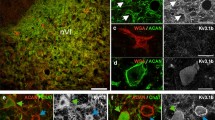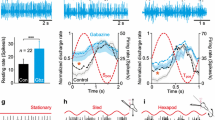Summary
Intracellular and extracellular responses were recorded with glass micro-electrodes from motoneurons in the IIIrd and IVth cranial nuclei of anesthesized rabbits. Five subgroups of neurons innervating the superior rectus (SR), inferior oblique (IO), inferior rectus (IR), medial rectus (MR), and superior oblique (IVth) extraocular muscles were identified by their antidromic activation from the branches of the IIIrd and IVth cranial nerves. The relative positions of the subgroups thus determined were consistent with the histological data on the rabbit. In the SR, IO, IR, and IVth subgroups the effects of ipsilateral VIIIth nerve stimulation were inhibitory, producing disynaptic IPSPs, while the effects of contralateral VIIIth nerve stimulation were excitatory, producing disynaptic EPSPs. In the MR subgroup, however, a mixture of EPSPs and IPSPs was produced by VIIIth nerve stimulation: this was particularly clear on the ipsilateral side. Sites relaying these VIIIth nerve effects to each of the five subgroups were explored by direct stimulation of various brain stem sites. Stimulation of the superior vestibular nucleus (SV) produced IPSPs monosynaptically in all five subgroups on the ipsilateral side as well as in the contralateral MR subgroup. Stimulation of the medial vestibular nucleus (MV) produced EPSPs monosynaptically in all of the five subgroups on the contralateral side as well as in the ipsilateral MR subgroup. Stimulation of the brachium conjunctivum (BC) also produced EPSPs monosynaptically in the contralateral SR, IO, and IR subgroups. Further, while the recording electrode was placed within each of the five subgroups to observe the extracellular potentials corresponding to the intracellularly recorded IPSPs and EPSPs, the medulla and cerebellum were systematically tracked with a monopolar stimulating electrode. It was thus confirmed that the SV is the sole inhibitory relay site, while excitation is relayed by both the MV and the BC. The origin of the BC pathway was traced to the Y-Group for the IO, to the lateral nucleus of the cerebellum (LN) for the IR, and to both the Y-Group and the LN for the SR subgroup.
Similar content being viewed by others
References
Azzena, G.B., Giretti, M.L.: Responses of the oculomotor units to deep cerebellar stimulation Brain Res. 6, 523–534 (1967).
Baker, R., Precht, W.: Eleotrophysiological properties of trochlear motoneurons as revealed by IVth nerve stimulation. Exp. Brain Res. 14, 127–157 (1972).
Bienfang, D.C.: Location of the cell bodies of the superior rectus and inferior oblique motoneurons in the cat. Exp. Neurol. 21, 455–466 (1968).
Brodal, A., Høivik, B.: Site and mode of primary vestibulo-cerebellar fibers in the cat. Arch. ital. Biol. 102, 1–21 (1964).
Carpenter, M.B., Strominger, N.C.: Cerebello-oculomotor fibers in the rhesus monkey. J. comp. Neurol. 123, 211–230 (1964).
Cohen, B.: The vestibulo-ocular reflex arc. In: Handbook of sensory physiology, Kornhuber (Ed.). Vol. 6: Vestibular system. Berlin-Heidelberg-New York: Springer 1972.
Collewijn, H.: An analog model of the rabbit's optokinetic system. Brain Res. 36, 71–88 (1972).
Fluur, E., Mellstrom, A.: Saccular stimulation and oculomotor reactions. Laryngoscope (St. Louis) 80, 1713–1721 (1970).
Fuse, G.: Die innere Abteilung des Kleinhirnstieles (Meynert I, A.K.) und der Deitersche Kern. Arb. Hirnanat. Imst. (Zürich) 6, 29–267 (1912).
Gacek, R.R.: The course and central termination of first order neurons supplying vestibular end organs in the cat. Acta oto-laryng. (Stockh.) Suppl. 254, 1–66 (1969).
—: Anatomical demonstration of the vestibulo-ocular projections in the cat. Laryngoscope (St. Louis) 81, 1559–1595 (1971).
Highstein, S.M.: Organization of the inhibitory and excitatory vestibuloocular reflex pathways to the third and fourth nuclei in rabbit. Brain Res. 32, 218–224 (1971).
Highstein, S.M. Electrophysiological investigation of the organization of the vestibulo-ocular pathways in rabbit. In: Cortical Control of Eye Movements, J. Dichgans and E. Bizzi (Eds.). Bibl. ophthal. (Basel) 83, 497–504 (1972).
—: Synaptic linkage in the vestibulo-ocular and cerebello-vestibular pathways to the VIth nucleus in the rabbit. Exp. Brain Res. 17, 301–314 (1973).
—, Ito, M., Tuchiya, T.: Synaptic linkage in the vestibulo-ocular reflex pathway of the rabbit. Exp. Brain Res. 13, 306–326 (1971).
Jongkees, L.B.W.: On the function of the saccule. Acta oto-laryng. (Stockh.) Suppl. 38, 18–26 (1950).
Lorente de Nó, R.: Anatomy of the eight nerve; The central projection of the nerve endings of the internal ear. Laryngoscope (St. Louis) 43, 1–38 (1933).
— Conduction of impulses in the neurons of the oculomotor nucleus. In: The Spinal Cord, a Ciba Eundation Symposium, pp. 132–179. London: J. & A. Churchill 1953.
Matano, S., Zyo, K., Ban, T.: Experimental studies on the medial longitudinal fasiculus in the rabbit; 1. Fibers originating in the vestibular nuclei. Med. J. Osaka Univ. 14, 339–370 (1964).
McMasters, R.E., Weiss, A.H., Capenter, M.B.: Vestibular projections to the nuclei of the extraocular muscles; Degeneration resulting from discrete partial lesions of the vestibular nuclei in the monkey. Amer. J. Anat. 118, 163–194 (1966).
Messen, H., Olszewsky, J.A.: A cytoarchitectonic atlas of the rhombencephalon of the rabbit, pp. 1–52. Basel: Karger 1949.
Precht, W., Baker, R.: Synaptic organization of the vestibulo-trochlear pathway. Exp. Brain Res. 14, 158–184 (1972).
Ramón y Cajal, S.: Histologie du système nerveux de l'homme et des vertébrés. Paris: Malonie 1911.
Suzuki, J.I., Cohen, B., Bender, M.B.: Compensatory eye movements induced by vertical semicircular canal stimulation. Exp. Neurol. 9, 137–160 (1964).
Thomas, R.C., Wilson, V.J.: Marking single neurons by staining with intracellular recording microelectrodes. Science 151, 1538–1539 (1966).
Tarlov, E.: Organization of vestibulo-oculomotor projections in the cat. Brain Res. 20, 150–179 (1970).
—, Tarlov, S.R.: The representation of extraocular muscles in the oculomotor nuclei: Experimental studies in the cat. Brain Res. 34, 37–52 (1971).
Van Rossum, J.: Corticonuclear and corticovestibular projections of the cerebellum. Van Gorcum and Co. 1969.
Warwick, R.: Representation of the extraocular muscles in the oculomotor nuclei of the monkey. J. comp. Neurol. 98, 449–504 (1953).
Author information
Authors and Affiliations
Rights and permissions
About this article
Cite this article
Highstein, S.M. The organization of the vestibulo-oculomotor and trochlear reflex pathways in the rabbit. Exp Brain Res 17, 285–300 (1973). https://doi.org/10.1007/BF00234667
Received:
Issue Date:
DOI: https://doi.org/10.1007/BF00234667




